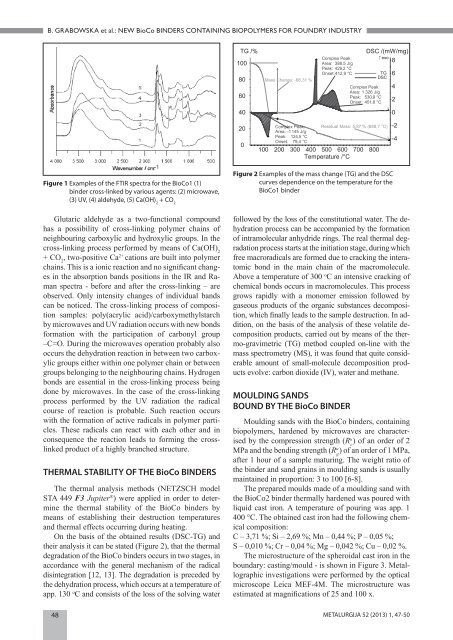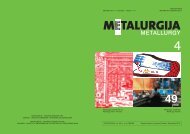Metalurgija: sadašnjost Metallurgy: Present Metalurgija ... - CARNet
Metalurgija: sadašnjost Metallurgy: Present Metalurgija ... - CARNet
Metalurgija: sadašnjost Metallurgy: Present Metalurgija ... - CARNet
Create successful ePaper yourself
Turn your PDF publications into a flip-book with our unique Google optimized e-Paper software.
B. GRABOWSKA et al.: NEW BioCo BINDERS CONTAINING BIOPOLYMERS FOR FOUNDRY INDUSTRY<br />
Figure 1 Examples of the FTIR spectra for the BioCo1 (1)<br />
binder cross-linked by various agents: (2) microwave,<br />
(3) UV, (4) aldehyde, (5) Ca(OH) 2 + CO 2<br />
Glutaric aldehyde as a two-functional compound<br />
has a possibility of cross-linking polymer chains of<br />
neighbouring carboxylic and hydroxylic groups. In the<br />
cross-linking process performed by means of Ca(OH) 2<br />
+ CO 2 , two-positive Ca 2+ cations are built into polymer<br />
chains. This is a ionic reaction and no signifi cant changes<br />
in the absorption bands positions in the IR and Raman<br />
spectra - before and after the cross-linking – are<br />
observed. Only intensity changes of individual bands<br />
can be noticed. The cross-linking process of composition<br />
samples: poly(acrylic acid)/carboxymethylstarch<br />
by microwaves and UV radiation occurs with new bonds<br />
formation with the participation of carbonyl group<br />
–C=O. During the microwaves operation probably also<br />
occurs the dehydration reaction in between two carboxylic<br />
groups either within one polymer chain or between<br />
groups belonging to the neighbouring chains. Hydrogen<br />
bonds are essential in the cross-linking process being<br />
done by microwaves. In the case of the cross-linking<br />
process performed by the UV radiation the radical<br />
course of reaction is probable. Such reaction occurs<br />
with the formation of active radicals in polymer particles.<br />
These radicals can react with each other and in<br />
consequence the reaction leads to forming the crosslinked<br />
product of a highly branched structure.<br />
THERMAL STABILITY OF THE BioCo BINDERS<br />
The thermal analysis methods (NETZSCH model<br />
STA 449 F3 Jupiter ® ) were applied in order to determine<br />
the thermal stability of the BioCo binders by<br />
means of establishing their destruction temperatures<br />
and thermal effects occurring during heating.<br />
On the basis of the obtained results (DSC-TG) and<br />
their analysis it can be stated (Figure 2), that the thermal<br />
degradation of the BioCo binders occurs in two stages, in<br />
accordance with the general mechanism of the radical<br />
disintegration [12, 13]. The degradation is preceded by<br />
the dehydration process, which occurs at a temperature of<br />
app. 130 o C and consists of the loss of the solving water<br />
100 200 300 400 500 600 700 800<br />
Temperature /°C<br />
followed by the loss of the constitutional water. The dehydration<br />
process can be accompanied by the formation<br />
of intramolecular anhydride rings. The real thermal degradation<br />
process starts at the initiation stage, during which<br />
free macroradicals are formed due to cracking the interatomic<br />
bond in the main chain of the macromolecule.<br />
Above a temperature of 300 o C an intensive cracking of<br />
chemical bonds occurs in macromolecules. This process<br />
grows rapidly with a monomer emission followed by<br />
gaseous products of the organic substances decomposition,<br />
which fi nally leads to the sample destruction. In addition,<br />
on the basis of the analysis of these volatile decomposition<br />
products, carried out by means of the thermo-gravimetric<br />
(TG) method coupled on-line with the<br />
mass spectrometry (MS), it was found that quite considerable<br />
amount of small-molecule decomposition products<br />
evolve: carbon dioxide (IV), water and methane.<br />
MOULDING SANDS<br />
BOUND BY THE BioCo BINDER<br />
DSC /(mW/mg)<br />
Moulding sands with the BioCo binders, containing<br />
biopolymers, hardened by microwaves are characterised<br />
by the compression strength (Ru) of an order of 2<br />
c<br />
MPa and the bending strength (Ru) of an order of 1 MPa,<br />
g<br />
after 1 hour of a sample maturing. The weight ratio of<br />
the binder and sand grains in moulding sands is usually<br />
maintained in proportion: 3 to 100 [6-8].<br />
The prepared moulds made of a moulding sand with<br />
the BioCo2 binder thermally hardened was poured with<br />
liquid cast iron. A temperature of pouring was app. 1<br />
400 °C. The obtained cast iron had the following chemical<br />
composition:<br />
C – 3,71 %; Si – 2,69 %; Mn – 0,44 %; P – 0,05 %;<br />
S – 0,010 %; Cr – 0,04 %; Mg – 0,042 %; Cu – 0,02 %.<br />
The microstructure of the spheroidal cast iron in the<br />
boundary: casting/mould - is shown in Figure 3. Metallographic<br />
investigations were performed by the optical<br />
microscope Leica MEF-4M. The microstructure was<br />
estimated at magnifi cations of 25 and 100 x.<br />
48 METALURGIJA 52 (2013) 1, 47-50<br />
TG /%<br />
100<br />
80<br />
60<br />
40<br />
20<br />
0<br />
Mass Change: -68,31 %<br />
Complex Peak:<br />
Area: -1 145 J/g<br />
Peak: 124,5 °C<br />
Onset: 79,4 °C<br />
Complex Peak:<br />
Area: 388,5 J/g<br />
Peak: 429,2 °C<br />
Onset: 412,9 °C<br />
TG<br />
DSC<br />
Complex Peak:<br />
Area: 1 326 J/g<br />
Peak: 530,9 °C<br />
Onset: 451,8 °C<br />
↑ exo<br />
Residual Mass: 5,87 % (888,7 °C)<br />
Figure 2 Examples of the mass change (TG) and the DSC<br />
curves dependence on the temperature for the<br />
BioCo1 binder<br />
[1]<br />
[1]<br />
8<br />
6<br />
4<br />
2<br />
0<br />
-2<br />
-4
















